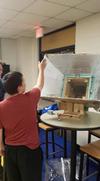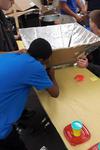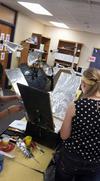Research and Design Part 2
by James Wampler
(Shelbyville, Ky. USA)

At the end of this week, we begin testing our designs. My plans for next year are to begin this much earlier. I thought that with the entire month of May, we would be in good shape...but our month broke down like this:
First full week of May - introduction into Solar cooking, connecting it to standards about human impacts on the environment, initial research and paper design
Second full week of May - State testing for 4 days, 1 day of field trip (We managed to squeeze in designing in the cafeteria after testing...but the students were understandably drained.)
Third week of May - 4 day week, only 2 full days of classes (lots of assemblies and reward days). Final design and testing *should* occur during this week, weather permitting
Fourth week of May - 3 days of seeing students. Two days of review, 1 final. (We have 4 total days, but the final is two classes long, so we break it up.)
If only we had a more predictable amount of sun! Starting earlier next year will keep my stress level down.
A few pointers to those looking to build cookers in large groups: I had 140 8th grade students working on solar cookers in the cafeteria. When I moved it into my (too small) room, i had to be efficient with space and organization.
1.) You can see on the pictures that I put some string through the aluminum foil tubes and tied that string to some pieces of wood that were attached to student tables. This made it easy for students to get to the aluminum foil and kept my hoarders from hoarding.
I thought of it last minute, otherwise i would have done the same thing with the duct tape. That tends to disappear quickly.
2.) You'll also notice that I have the glue in play-doh containers that are hot glued to the tops of tupperware containers. This keeps them from being tipped over easily in high excitement type environments.
3.) The tables are covered because no matter how careful your students are, they will get glue (and paint!) all over your tables.
4.) Depending on how much you trust your students (and what your school will allow) the cutting of cardboard can present some difficulty. We discovered that just taking a pen with a ruler and drawing the same line over time (with pressure) will weaken the cardboard enough for it to be cut easily with scissors.
If that is too low-budget, there is a great device called a "klever kutter" which is a pretty safe way to cut cardboard under supervision. A less safe (but still safer than exacto knives) is the "Slice" line of ceramic box cutters. Get the ones with the auto retracting blades so that careless students don't leave a sharp edge out.
I had very few people helping in the cafeteria, so I elected to make my students to the pen-scissors method.
I couldn't be happier with how the student projects have turned out. It is a great way to end the year. Normally students tend to give up after state testing. This keeps them engaged and learning up until the end.
Comments for Research and Design Part 2
|
||
|
||
SOLAR COOKER CATEGORIES
Panel Cookers
Box Cookers
Parabolic Cooker
Evacuated Cookers
Accessories
Discontinued CookersNew Financing Options available for purchase of Solar Cookers









